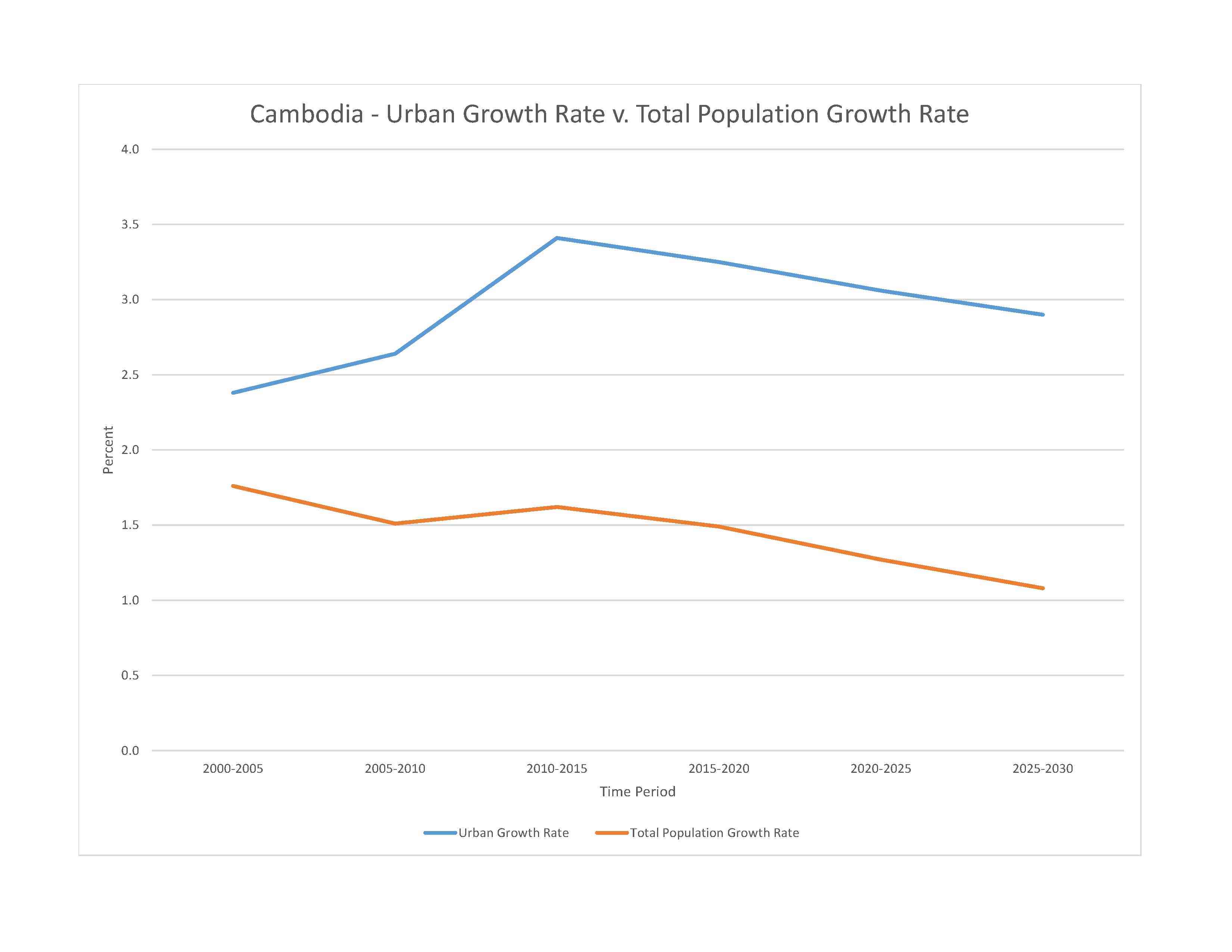
16,891,245 (2023 est.)
noun: Cambodian(s)
adjective: Cambodian
Khmer 95.4%, Cham 2.4%, Chinese 1.5%, other 0.7% (2019-20 est.)
Khmer (official) 95.8%, minority languages 2.9%, Chinese 0.6%, Vietnamese 0.5%, other 0.2% (2019 est.)
major-language sample(s):
សៀវភៅហេតុការណនៅលើពិភពលោក។ ទីតាំងពត៏មានមូលដានគ្រឹះយាងសំខាន់។. (Khmer)
The World Factbook, the indispensable source for basic information.
Khmer audio sample:
Buddhist (official) 97.1%, Muslim 2%, Christian 0.3%, other 0.5% (2019 est.)
Cambodia is a predominantly rural country with among the most ethnically and religiously homogenous populations in Southeast Asia: more than 95% of its inhabitants are Khmer and more than 95% are Buddhist. The population’s size and age structure shrank and then rebounded during the 20th century as a result of conflict and mass death. During the Khmer Rouge regime between 1975 and 1979 as many as 1.5 to 2 million people are estimated to have been killed or died as a result of starvation, disease, or overwork – a loss of about 25% of the population. At the same time, emigration was high, and the fertility rate sharply declined. In the 1980s, after the overthrow of the Khmer Rouge, fertility nearly doubled and reached pre-Khmer Rouge levels of close to 7 children per woman, reflecting in part higher infant survival rates. The baby boom was followed by a sustained fertility decline starting in the early 1990s, eventually decreasing from 3.8 in 2000 to 2.9 in 2010, although the rate varied by income, education, and rural versus urban location. Despite continuing fertility reduction, Cambodia still has a youthful population that is likely to maintain population growth through population momentum. Improvements have also been made in mortality, life expectancy, and contraceptive prevalence, although reducing malnutrition among children remains stalled. Differences in health indicators are pronounced between urban and rural areas, which experience greater poverty.
Cambodia is predominantly a country of migration, driven by the search for work, education, or marriage. Internal migration is more prevalent than international migration, with rural to urban migration being the most common, followed by rural to rural migration. Urban migration focuses on the pursuit of unskilled or semi-skilled jobs in Phnom Penh, with men working mainly in the construction industry and women working in garment factories. Most Cambodians who migrate abroad do so illegally using brokers because it is cheaper and faster than through formal channels, but doing so puts them at risk of being trafficked for forced labor or sexual exploitation. Young Cambodian men and women migrate short distances across the Thai border using temporary passes to work in agriculture, while others migrate long distances primarily into Thailand and Malaysia for work in agriculture, fishing, construction, manufacturing, and domestic service. Cambodia was a refugee sending country in the 1970s and 1980s as a result of the brutality of the Khmer Rouge regime, its ousting by the Vietnamese invasion, and the resultant civil war. Tens of thousands of Cambodians fled to Thailand; more than 100,000 were resettled in the US in the 1980s. Cambodia signed a multi-million dollar agreement with Australia in 2014 to voluntarily resettle refugees seeking shelter in Australia. However, the deal has proven to be a failure because of poor conditions and a lack of support services for the few refugees willing to accept the offer.
0-14 years: 29.47% (male 2,518,910/female 2,459,235)
15-64 years: 65.39% (male 5,362,180/female 5,682,247)
65 years and over: 5.14% (2023 est.) (male 308,931/female 559,742)
total dependency ratio: 53.4
youth dependency ratio: 45
elderly dependency ratio: 8.5
potential support ratio: 11.8 (2021 est.)
total: 27.6 years (2023 est.)
male: 26.6 years
female: 28.5 years
1.04% (2023 est.)
18.8 births/1,000 population (2023 est.)
5.7 deaths/1,000 population (2023 est.)
-2.7 migrant(s)/1,000 population (2023 est.)
population concentrated in the southeast, particularly in and around the capital of Phnom Penh; further distribution is linked closely to the Tonle Sap and Mekong Rivers
urban population: 25.6% of total population (2023)
rate of urbanization: 3.06% annual rate of change (2020-25 est.)

2.281 million PHNOM PENH (capital) (2023)
at birth: 1.05 male(s)/female
0-14 years: 1.02 male(s)/female
15-64 years: 0.94 male(s)/female
65 years and over: 0.55 male(s)/female
total population: 0.94 male(s)/female (2023 est.)
23.3 years (2021-22 est.)
note: data represents median age at first birth among women 25-49
218 deaths/100,000 live births (2020 est.)
total: 28.8 deaths/1,000 live births (2023 est.)
male: 32.2 deaths/1,000 live births
female: 25.1 deaths/1,000 live births
total population: 71 years (2023 est.)
male: 69.2 years
female: 73 years
2.2 children born/woman (2023 est.)
1.08 (2023 est.)
56.3% (2014)
improved: urban: 99.3% of population
rural: 80.6% of population
total: 85.1% of population
unimproved: urban: 0.7% of population
rural: 19.4% of population
total: 14.9% of population (2020 est.)
7.5% of GDP (2020)
0.19 physicians/1,000 population (2014)
1.9 beds/1,000 population (2016)
improved: urban: 100% of population
rural: 69.3% of population
total: 76.8% of population
unimproved: urban: 0% of population
rural: 30.7% of population
total: 23.2% of population (2020 est.)
degree of risk: very high (2023)
food or waterborne diseases: bacterial diarrhea, hepatitis A, and typhoid fever
vectorborne diseases: dengue fever, Japanese encephalitis, and malaria
animal contact diseases: Rabies
3.9% (2016)
total: 4.56 liters of pure alcohol (2019 est.)
beer: 4.12 liters of pure alcohol (2019 est.)
wine: 0.03 liters of pure alcohol (2019 est.)
spirits: 0.41 liters of pure alcohol (2019 est.)
other alcohols: 0 liters of pure alcohol (2019 est.)
total: 21.1% (2020 est.)
male: 36.1% (2020 est.)
female: 6% (2020 est.)
16.3% (2022)
66.4% (2023 est.)
3.1% of GDP (2020 est.)
definition: age 15 and over can read and write
total population: 83.9%
male: 88.4%
female: 79.8% (2021)
NOTE: The information regarding Cambodia on this page is re-published from the 2024 World Fact Book of the United States Central Intelligence Agency and other sources. No claims are made regarding the accuracy of Cambodia 2024 information contained here. All suggestions for corrections of any errors about Cambodia 2024 should be addressed to the CIA or the source cited on each page.
This page was last modified 04 May 24, Copyright © 2024 ITA all rights reserved.